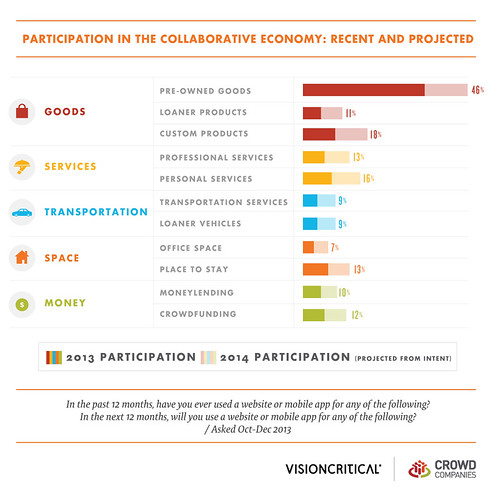Collaborative Economy Adoption is Going to Double
Respondents in the largest study in the new peer-to-peer economy reported that they plan to double usage in next 12 months. Brands must develop a strategy in this new market and avoid being bypassed from peer-to-peer economic models.

Above Graphic: Dark colored bars indicate adoption in last 12 months, light colored bars indicate adoption in next 12 months; this nascent market is quickly growing.
Read the full report which surveyed over 90,000 people: Sharing is the New Buying
This post is a section of a March 2013 report on the collaborative economy, in which I partnered with Vision Critical, titled, “Sharing is the new buying.” You can download the whole report and read the coverage by Fast Company: “The Collaborative Economy Is Exploding, and Brands That Ignore It Are Out of Luck.” We asked thousands of respondents about their past usage (the dark colored bars) and their intent to use over the next 12 months (the light colored bars), helping us to forecast growth. The purpose of this post is to drive deeper into one of the key findings, the forecast, here’s what we found:
- Even in new markets, adoption is doubling in most categories. For sharing of goods (sites like eBay and Craigslist), we found there’s significant growth in the sharing of used goods (up to 46%), but the overall growth rate is slowing. In nearly every category, at least as many people intend to try sharing in the next 12 months as have tried it in the past 12 months. There is no runaway category for prospective growth. Nearly every category of neo-sharing enjoys similar levels of interest from prospective users: 4% to 9% intend to try it in the next 12 months. With that said, there’s greater interest in custom products (the Maker Movement), personal services (PopExpert, TaskRabbit), places to stay (Airbnb, VRBO, HomeAway), and crowd-funding (Kickstarter and Indiegogo) indicate they may enjoy double-digit adoption rates.
- Anticipate that much of growth will be driven by Neo-Sharers. This persona type is an individual who shares much of their life across goods, services, transportation, space and money – I’m trying to incorporate much of it into my work and lifestyle to better understand it. Neo-sharing could double in the next 12 months. In all the neo-sharing categories, there are roughly equal numbers of recent and prospective users, and there are more of them every day. In most categories of sharing, 12 to 15% of neo-sharers who haven’t tried that type of sharing say they will in the next 12 months. (For custom products, it’s even higher: 17%. For office space, it’s a little lower: 10%.) This means that much of the growth of sharing will come from existing neo-sharers who are broadening the range of neo-sharing services they use.
- Maker Movement showing solid growth, via Crowd-funding and Custom Goods. I’ve watched with great interest at how the Kickstarter community was able to produce a digital watch (Touch Time and Pebble) before large consumer electronics companies could get to market. Custom products, which is also referred to as the Maker Movement, are the type of neo-sharing that interests the most prospective users. In the past 12 months, 9% of the population has shared custom products and another 9% intend to try it in the next 12. But that’s only a narrow advantage over other categories of neo-sharing. For corporations tapping co-innovation initiatives this is an excellent opportunity to partner with the crowd to co-fund, co-design, co-build, products alongside the crowd.
Peer to peer threaten traditional corporations as people share or build –rather than buy. This means that people want new business models to get goods that they seek by using an access model, rather than traditional ownership models. The logic suggests that they will tap crowd services like oDesk rather than traditional consulting firms, stay at Airbnbs as opposed to hotels, take Lyft rather than traditional taxis, and borrow and lend money in Lending Club instead of using traditional banks. It also means that people will their own Makers as they fund, build, and buy custom made goods from their fellow peers – rather than from traditional corporations.
New market opportunities for innovative companies that move now in the early phases of market. The Collaborative Economy is a generally new market where the majority of tech startups have been around less than five years. This provides unique opportunities for brands that want to leverage the movement to their benefit and that of those participating. Get ready, as the economy starts to shift to crowd-based business models. You can alter your business model to leverage this movement (see this storyboard on the business model shift required, see this timeline of brand examples, peruse the body of knowledge on this topic). If you’re a large company, contact me to discover how Catalyst Companies council can help you to learn more, then move to action.